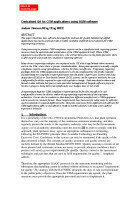Air Monitoring
Centralised QA for CEM applications using AQM software
Oct 06 2014
Author: Andrew Newman on behalf of CEM
ABSTRACT:
This paper illustrates how software developed for ambient Air Quality Monitoring (AQM) applications has been used to provide a readily available and field tested solution for CEM reporting requirements.
Data processing to produce CEM compliance reports can be a significant task, requiring greater resource than the operation and maintenance of the CEM equipment itself. Where CEM equipment is specified by main contractors, who will not themselves be the plant operators there is often no provision made for compliance reporting software.
Many diverse reporting strategies are employed in the UK which lags behind other countries, such as the USA, where there is greater standardisation. Some plant operators manually compile compliance reports using spreadsheets, which is far from cost effective. Proprietary reporting packages from the CEM equipment manufacturers are also employed but are product specific. Incorporating the compliance report generation into the plant's Supervisory Control and Data Acquisition (SCADA) or Distributed Control (DCS) systems can be expensive and lacks the user configurable flexibility required to cope with legislative change. Both anecdotal evidence and formal studies indicate that poor or non-specialist management of bespoke software projects results in projects being delivered significantly over budget, late, or not at all.
A reporting package for CEM compliance reporting must be flexible enough to be user configurable to meet the diverse and evolving reporting requirements of the regulatory authorities. It must also be modular so that data from different manufacturer's CEM equipment can be saved in a common format. These requirements have been met for many years by software used in national or regional AQM networks. Using the experience from AQM network software for CEM applications offers a cost effective, ready to market solution, with many years of field experience behind it.
1. Introduction:
It is a peculiarity of the UK's 1990 Environmental Protection Act, that plant operators themselves carry out the majority of the continuous emissions monitoring, and then regularly present the results to the regulatory authority, who may be the Environment Agency or local authority depending upon the process.[1] In order to comply with this approach, plant operators must agree an appropriate technique for monitoring, following the BATNEEC principle (Best Available Technology not Entailing Excessive Cost). Confidence in this system can only be maintained if the quality of the data presented is high. The concepts of quality assurance and quality control are usefully defined by the British Standard BS EN 9000: "Quality assurance consists of all those planned and systematic actions necessary to provide adequate confidence that a product will satisfy given requirements for quality. Quality control is the operational techniques and activities that are used to fulfil requirements for quality.". (emphasis added).
Therefore, the appropriate QA/QC protocols for the emissions monitoring and the subsequent data handling cannot be defined without reference to an agreed "requirement for quality". By analogy with the BATNEEC principle, the duty of care is proportionate to the public policy objectives. Once the CEM requirements are agreed, the plant operators must provide the appropriate personnel and tools to implement it.
The Environment Agency also undertakes independent monitoring through the National Compliance Assessment Service. Although the independent contractors employed are much more experienced than typical site operators, the Agency has still found that "inadequate prescription and poor formatting ..... has meant that consistent high quality reporting has often only been achieved after considerable debate and difficult contractual discussions with the contractors". [2]
Unfortunately, where CEM is to be undertaken by plant operators the practicalities of data handling and reporting are often not sufficiently anticipated. As CEM equipment manufacturers it is common to receive specifications for tenders where no allowance for this has been made, and sometimes no provision even for collecting data. Where plant is being purchased by main contractors who will not themselves be operating the plant, essential equipment maintenance is also sometimes omitted.
So plant operators starting to operate CEM equipment often find that they have no mechanism in place for controlling the data and summarising it to produce a report. CEM equipment requires operation by skilled technicians, but the data quality is also dependant upon having skilled staff who appreciate how to deal with measurement uncertainty and statistical analysis.
Software tools are invaluable is bringing this task within the resource capability of plant operators. The non-prescriptive approach of UK emissions regulations has meant that there is no common protocol for data management and no common format for reporting, this has restricted the market for software tools and impeded their development.
Digital Edition
IET 34.2 March 2024
April 2024
Gas Detection - Biogas batch fermentation system for laboratory use with automatic gas analysis in real time Water/Wastewater - Upcycling sensors for sustainable nature management - Prist...
View all digital editions
Events
Apr 30 2024 Melbourne, Australia
Apr 30 2024 Birmingham, UK
May 03 2024 Seoul, South Korea
May 05 2024 Seville, Spain
May 06 2024 Minneapolis, MN, USA















